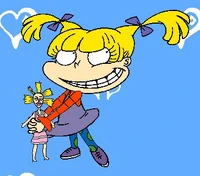Josie
Andrews
Supplemental
Post #2
This week-end, I went to see Peter Rabbit (Sony, 2018) …. seriously, I did. Sony’s latest live action-animation hybrid made effortless good, old-fashioned slapstick humor and double entendre had the entire audience (myself included) in stitches. Not surprisingly, James Corden steals the show as a lovable, cheeky rabbit who literally causes a calamity every other minute in the film. Putting aside the amazing real human interaction of Domhnall Gleeson and Rose Byrne with the CGI animals and the rap/pop songs, I recognized immediately several other celebrity voices in the animation, including Sia (Mrs. Tiffly-Winkle) and Margot Robbie (Flopsy and narrator). Since our class is about Stars, this made me wonder two things: (1) when did the industry switch from professional voiceover actors to celebrity voices; and (2) why did the industry switch?

My favorite animated show when I was little was Nickelodeon’s
Rugrats. I absolutely loved Angelica.
But, I wouldn’t know Cheryl Chase, the voice of Angelica, if she was standing beside
me in an elevator. In fact, I had to look up Angelica’s voice just to write
this post. Like Angelica, the voices of many beloved, animated characters,
including Snow White (1937), Cinderella (1950) or even Belle in Beauty and The Beast (1992) were largely
anonymous for most people, which meant we did not attribute any outside characteristics
or celebrity knowledge to the voice. But, today, celebrities have taken over the
world of animated movies and the profession of lead character voice acting. While
there are a few early examples of celebrity voice acting, e.g. Charlotte’s Web (1973) had Debbie
Reynolds, Paul Lynde and Agnes Moorhead, and The Rescuers (1977, Bob Newhart and Eva Gabor, my first real memory
of a “celebrity” voice in an animated film was the blockbuster hit Aladdin (1992) with the unmistakable voice
of Robin Williams as Genie. Today, we could not imagine a more perfect “fit” of
character and actor, with Williams breaking the fourth wall as he always does on
screen. Lion King (1994) with Jonathan Taylor
Thomas, James Earl Jones and Whoopie Goldberg, and Tom Hanks’ infamous voice as
Woody in Toy Story (1995) followed in quick
succession. Today, star-power is the norm for every lead in every major
Hollywood animated film. From Will Smith to Jerry Seinfeld to Idina Menzel to
Angelina Jolie to Cameron Diaz to Dustin Hoffman to Miley Cyrus and even Jim
Parson, the list goes on and on.
Why did Hollywood switch to star power? Certainly, it is cheaper to
use anonymous voice actors than these big stars. Nonetheless, I can think of a couple of
possible reasons—all of which are based purely on my own conjecture. First, usually Hollywood is all about the "Benjamins." I know there was a huge decline in animated film box office sales in the 1970s
and 1980s. Studios were likely trying to find a way to bring back to life
this important sector. In non-animated
films during the same time, the heyday of the auteur director had come to an
end by the 1980s, and a renewed interest in celebrity star power driving box
office sales arose. Seeing the early 1990s box office success of Eddie Murphy,
Robin Williams and other star-driven films, it is not surprising the studios
turned to “star power” to see if it could drive fans to see even animated
films, particularly adults who had to sit through these animated "kid" films. It worked and the idea took off. Parents, who could not take their children to
see most of their star films, now had a place to take kids and actually still
enjoy their favorite stars. The fact the animated characters started to look
and act like the stars' well-known characters and personalities was a definite plus—and, very
likely, expected and necessary for the film to succeed. And, if you could add
lots of double entendre and fourth wall winks at the adults in the audience…you
could have a huge hit!
Anyways, the movie is fun, and I personally enjoyed
the use of celebrities in the film, particularly since their star
characteristics are incorporated so well into the animation.

:origin()/pre00/9332/th/pre/i/2014/231/0/a/genie__a_robin_williams_tribute_by_jasminsc-d7vu2cy.png)
No comments:
Post a Comment